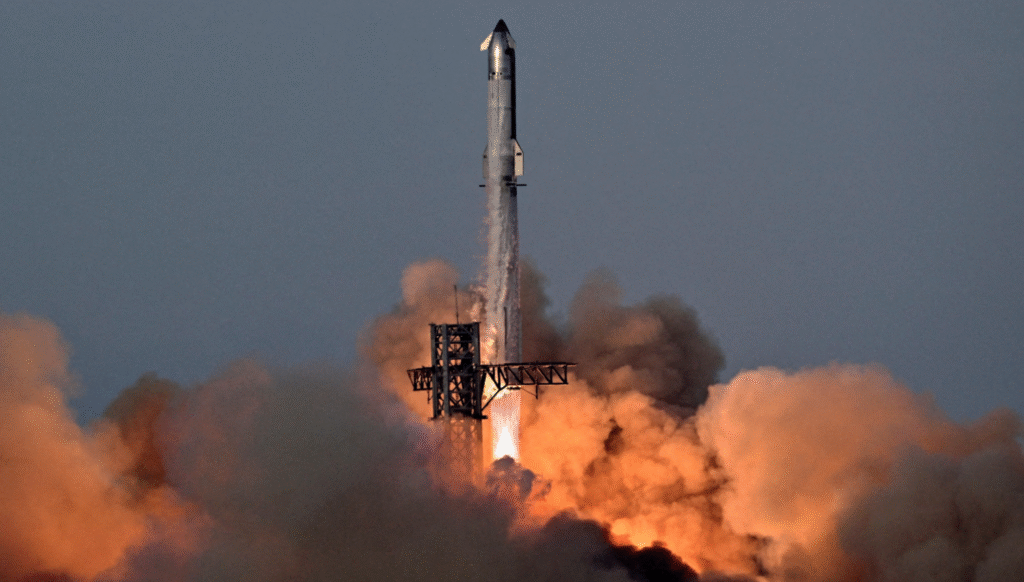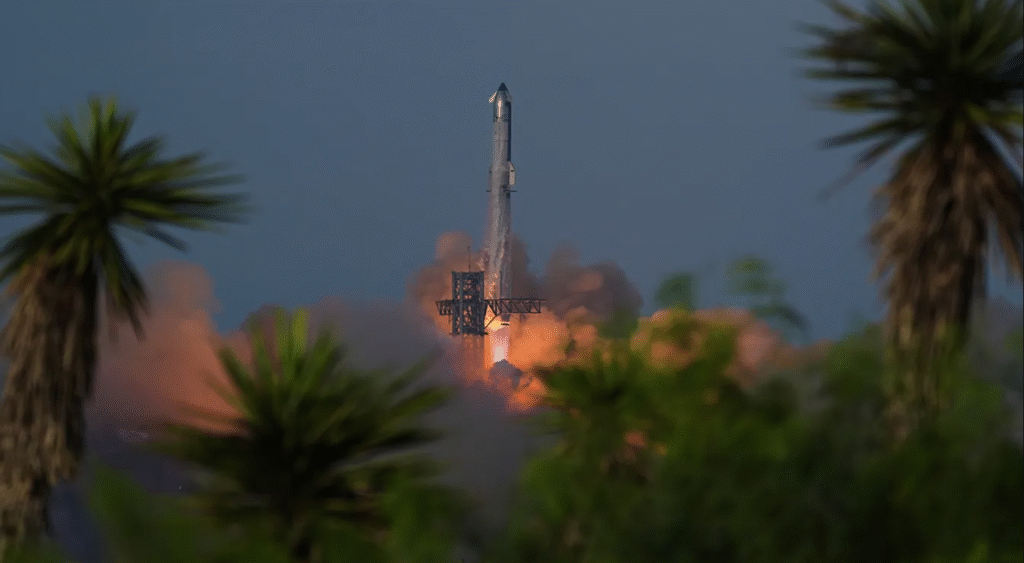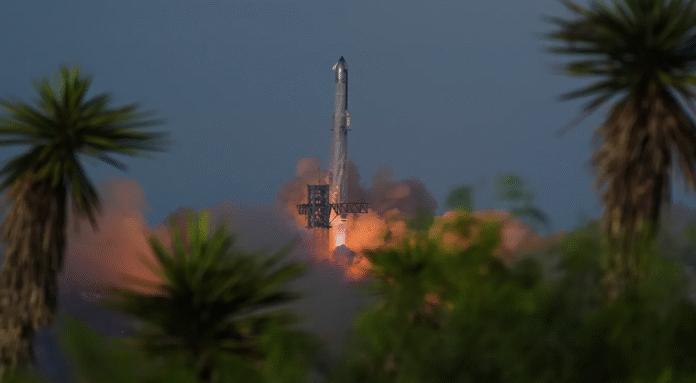The SpaceX Starship rocket comeback has finally arrived, marking a major victory for Elon Musk’s ambitious space program. After months of setbacks and explosive failures, SpaceX has successfully launched and tested the world’s most powerful rocket in what many are calling a breathtaking turnaround for the company’s future.
On Tuesday evening, the Starship system lifted off from Texas, stunning observers with a dramatic 60-minute flight that pushed the rocket’s limits while demonstrating undeniable progress. This success comes after three failed launches earlier this year, making the achievement all the more impressive.

SpaceX Starship Rocket Comeback Ignites Hope
The test flight began just after 18:30 local time, with all 33 engines of the Super Heavy booster roaring to life. Within minutes, the booster separated cleanly and fell into the Gulf of Mexico, while Starship itself continued its journey skyward.
The spacecraft climbed nearly 200 kilometers above Earth, coasting around the planet before re-entering the atmosphere. Although parts of the vehicle’s flaps caught fire and swung violently during descent, the mission demonstrated resilience. For SpaceX engineers, this test was designed to push the limits of the rocket, and the spacecraft returned battered but intact, a clear sign of progress.
NASA’s Lunar Dreams Ride on Starship
The SpaceX Starship rocket comeback carries implications far beyond the company itself. NASA has already signed a contract with SpaceX to use a modified Starship for its Artemis program, which plans to land astronauts on the Moon in 2027.
Although many experts believe that timeline will slip, Tuesday’s flight reassured NASA officials that Musk’s vision is moving closer to reality. If Starship can be certified for human travel in the coming years, it could reshape the future of space exploration.
For NASA, which once relied on the Saturn V rocket during the Apollo program, Starship represents the next leap in deep-space capability. With greater thrust and reusability, it promises to take humans not just back to the Moon, but eventually onward to Mars.
Elon Musk Celebrates a Victory
Following the successful test, SpaceX CEO Elon Musk shared his excitement on X, writing: “Great work by the SpaceX team!!”
The success comes at a crucial moment for Musk, who has faced criticism over multiple rocket explosions earlier this year. In March, debris from a failed Starship test rained down across the Bahamas, while a June launch ended in flames on the Texas launch pad. These failures raised questions about SpaceX’s “fail fast, learn fast” philosophy.
But with this latest test, Musk has silenced critics and proven the approach can deliver results. The SpaceX Starship rocket comeback demonstrates not only engineering progress but also the company’s determination to keep pushing forward despite setbacks.
Starship: The World’s Most Powerful Rocket
The successful test also reaffirms Starship’s status as the most powerful rocket ever built. Standing taller than NASA’s Saturn V, the rocket consists of two key components:
-
Super Heavy booster – 33 engines providing liftoff power
-
Starship spacecraft – designed for crew, cargo, and interplanetary missions
What sets Starship apart is its vision of full reusability. SpaceX aims for both the booster and spacecraft to return safely to Earth for future flights, dramatically cutting the cost of space travel.
During a previous test, SpaceX even executed its daring “chopstick maneuver,” where massive mechanical arms caught the descending booster, a glimpse into the future of reusable rockets.

Lessons Learned from Explosions
The SpaceX Starship rocket comeback only happened because of the lessons learned from past failures. Each explosion, while costly and dramatic, provided engineers with critical data.
For SpaceX, failure is not the end, it’s part of the process. By analyzing how components fail under stress, the company accelerates its ability to improve. This approach contrasts with more cautious aerospace traditions, but it has allowed SpaceX to innovate at an unprecedented pace.
Still, with three failures earlier this year, many questioned whether Musk was distracted by politics and other ventures. This successful launch shows that despite outside noise, SpaceX’s focus on innovation remains as sharp as ever.
Mars and Beyond: The Bigger Vision
While NASA looks to the Moon, Musk’s ambitions stretch further. The entrepreneur envisions Starship as the vehicle that will one day carry humans to Mars. He has suggested that uncrewed flights to the Red Planet could begin within the next 12 months, though such timelines are always subject to change.
The SpaceX Starship rocket comeback is a crucial step toward that vision. By proving Starship can survive demanding test flights, SpaceX inches closer to making interplanetary travel a reality.
Why This Comeback Matters
For SpaceX, NASA, and the future of human spaceflight, Tuesday’s successful mission is about more than just a rocket launch. It’s about resilience.
-
For SpaceX, it restores confidence after a string of failures.
-
For NASA, it keeps the Artemis program’s lunar dreams alive.
-
For humanity, it symbolizes a path toward Mars and beyond.
The SpaceX Starship rocket comeback proves that even after fiery setbacks, persistence and innovation can deliver stunning results.
Conclusion
The successful test flight of Starship marks a turning point not just for SpaceX but for the future of space exploration. From explosive failures to a triumphant comeback, this rocket continues to embody the spirit of bold experimentation.
As the battered spacecraft returned to Earth, it carried with it more than just burn marks, it carried renewed faith in the possibility of humans reaching new worlds. And with Elon Musk’s relentless vision, the countdown to the next giant leap has already begun.

